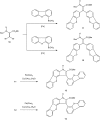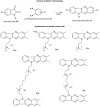Recent developments in the chemistry of deoxyribonucleic acid (DNA) intercalators: principles, design, synthesis, applications and trends
- PMID: 19471193
- PMCID: PMC6254398
- DOI: 10.3390/molecules14051725
Recent developments in the chemistry of deoxyribonucleic acid (DNA) intercalators: principles, design, synthesis, applications and trends
Abstract
In the present overview, we describe the bases of intercalation of small molecules (cationic and polar neutral compounds) in DNA. We briefly describe the importance of DNA structure and principles of intercalation. Selected syntheses, possibilities and applications are shown to exemplify the importance, drawbacks and challenges in this pertinent, new, and exciting research area. Additionally, some clinical applications (molecular processes, cancer therapy and others) and trends are described.
Figures













Similar articles
-
Molecular recognition of DNA by rigid [N]-polynorbornane-derived bifunctional intercalators: synthesis and evaluation of their binding properties.J Med Chem. 2007 May 17;50(10):2326-40. doi: 10.1021/jm0613020. Epub 2007 Apr 13. J Med Chem. 2007. PMID: 17429957
-
Harnessing DNA intercalation.Trends Biotechnol. 2007 Oct;25(10):433-6. doi: 10.1016/j.tibtech.2007.08.003. Epub 2007 Sep 7. Trends Biotechnol. 2007. PMID: 17825446 Review.
-
Design, synthesis, molecular docking and anti-proliferative evaluations of [1,2,4]triazolo[4,3-a]quinoxaline derivatives as DNA intercalators and Topoisomerase II inhibitors.Bioorg Chem. 2020 Dec;105:104399. doi: 10.1016/j.bioorg.2020.104399. Epub 2020 Oct 21. Bioorg Chem. 2020. PMID: 33113414
-
Click modification of diazido acridine intercalators: a versatile route towards decorated DNA nanostructures.Chemistry. 2015 Sep 1;21(36):12611-5. doi: 10.1002/chem.201501836. Epub 2015 Jul 21. Chemistry. 2015. PMID: 26216718
-
Recent advances in small organic molecules as DNA intercalating agents: synthesis, activity, and modeling.Eur J Med Chem. 2014 Mar 3;74:95-115. doi: 10.1016/j.ejmech.2013.11.029. Epub 2014 Jan 3. Eur J Med Chem. 2014. PMID: 24448420 Review.
Cited by
-
Theranostic nanoshells: from probe design to imaging and treatment of cancer.Acc Chem Res. 2011 Oct 18;44(10):936-46. doi: 10.1021/ar200023x. Epub 2011 May 25. Acc Chem Res. 2011. PMID: 21612199 Free PMC article. Review.
-
Synthesis, DNA binding and topoisomerase I inhibition activity of thiazacridine and imidazacridine derivatives.Molecules. 2013 Dec 6;18(12):15035-50. doi: 10.3390/molecules181215035. Molecules. 2013. PMID: 24322489 Free PMC article.
-
A Systems Biology Approach to Understanding the Mechanisms of Action of an Alternative Anticancer Compound in Comparison to Cisplatin.Proteomes. 2014 Nov 10;2(4):501-526. doi: 10.3390/proteomes2040501. Proteomes. 2014. PMID: 28250393 Free PMC article.
-
In silico study of HASDI (high-affinity selective DNA intercalator) as a new agent capable of highly selective recognition of the DNA sequence.Sci Rep. 2023 Apr 3;13(1):5395. doi: 10.1038/s41598-023-32595-4. Sci Rep. 2023. PMID: 37012345 Free PMC article.
-
Recent Developments in the Interactions of Classic Intercalated Ruthenium Compounds: [Ru(bpy)₂dppz]2+ and [Ru(phen)₂dppz]2+ with a DNA Molecule.Molecules. 2019 Feb 20;24(4):769. doi: 10.3390/molecules24040769. Molecules. 2019. PMID: 30791625 Free PMC article. Review.
References
-
- MacMillan A.M. Fifty years of "Watson-Crick". Pure Appl. Chem. 2004;76:1521–1524. doi: 10.1351/pac200476071521. - DOI
-
- MacMillan A.M. Chemistry of nucleic acids - Part 3 - Preface. Pure Appl. Chem. 2004;76 doi: 10.1351/pac200476071521. - DOI
-
- Jelly R., Lewis S.W., Lennard C., Lim K.F., Almog J. Lawsone: a novel reagent for the detection of latent fingermarks on paper surfaces. Chem. Commun. 2008:3513–3515. - PubMed
Publication types
MeSH terms
Substances
LinkOut - more resources
Full Text Sources
Other Literature Sources

